Abstract
Microspheres composed of biocompatible, biodegradable poly(DL-lactide-co-glycolide) (DL-PLG) and staphylococcal enterotoxin B (SEB) toxoid were evaluated as a vaccine delivery system when subcutaneously injected into mice. As measured by circulating immunoglobulin G (IgG) antitoxin titers, the delivery of SEB toxoid via DL-PLG microspheres, 1 to 10 microns in diameter, induced an immune response which was approximately 500 times that seen with nonencapsulated toxoid. The kinetics, magnitude, and duration of the antitoxin response induced with microencapsulated toxoid were similar to those obtained when an equal toxoid dose was administered as an emulsion with complete Freund adjuvant. However, the microspheres did not induce the inflammation and granulomata formation seen with complete Freund adjuvant. The adjuvant activity of the microspheres was not dependent on the superantigenicity of SEB toxin and was equally effective at potentiating circulating IgG antitrinitrophenyl levels in response to microencapsulated trinitrophenyl-keyhole limpet hemocyanin. Empty DL-PLG microspheres were not mitogenic, and SEB toxoid injected as a mixture with empty DL-PLG microspheres was no more effective as an immunogen than toxoid alone. Antigen-containing microspheres 1 to 10 microns in diameter exhibited stronger adjuvant activity than those greater than 10 microns, which correlated with the delivery of the 1- to 10-microns, but not the greater than 10-microns, microspheres into the draining lymph nodes within macrophages. The antibody response induced through immunization with microencapsulated SEB toxoid was protective against the weight loss and splenic V beta 8+ T-cell expansion induced by intravenous toxin administration. These results show that DL-PLG microsphere vaccine delivery systems, which are composed of pharmaceutically acceptable components, possess a strong adjuvant activity for their encapsulated antigens.
Full text
PDF
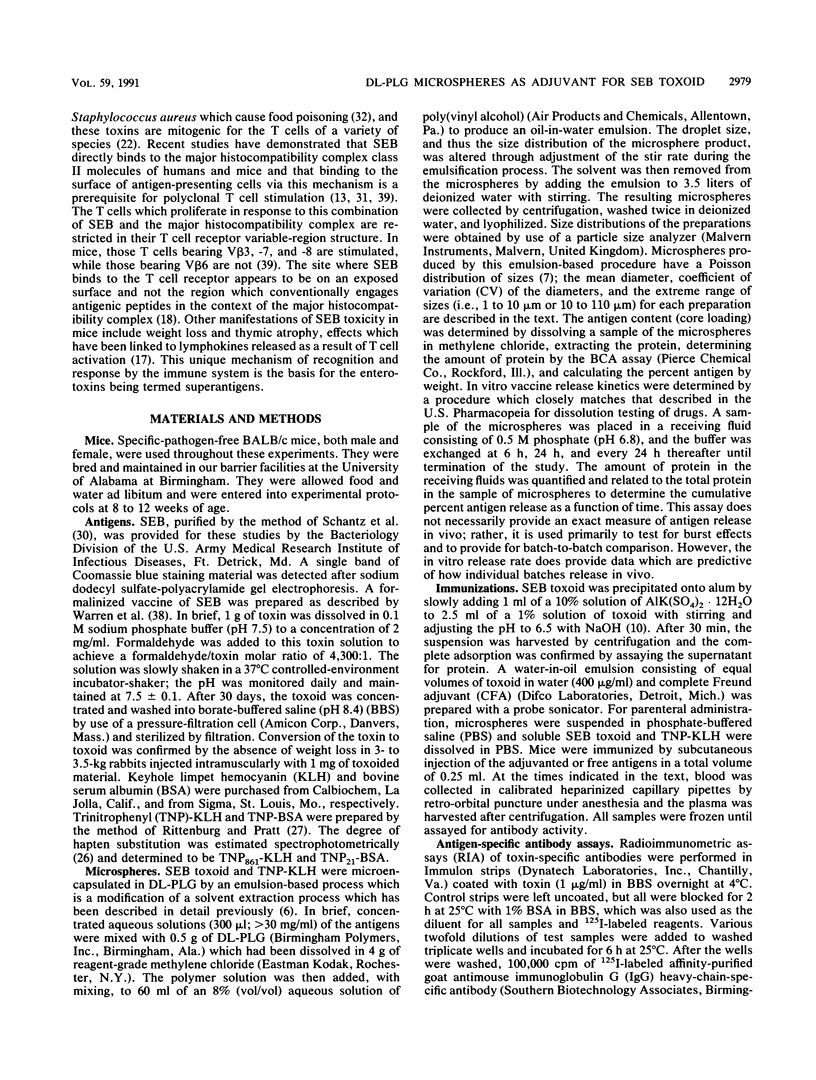
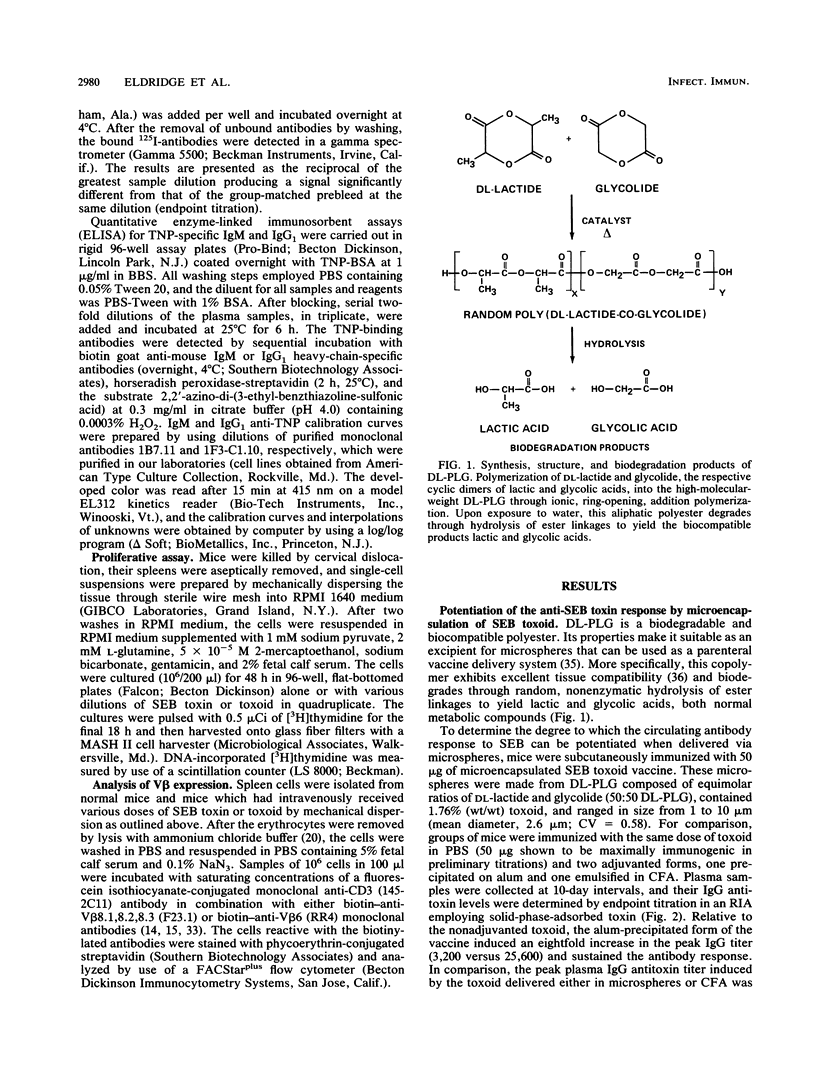



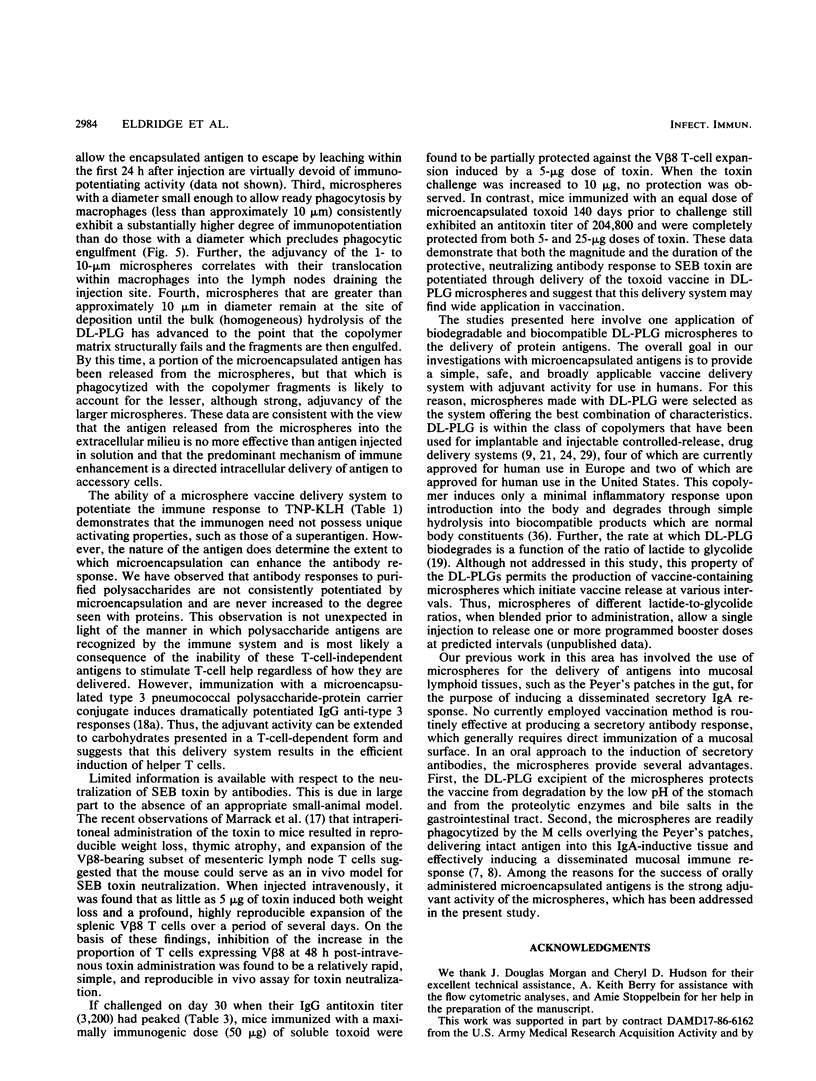
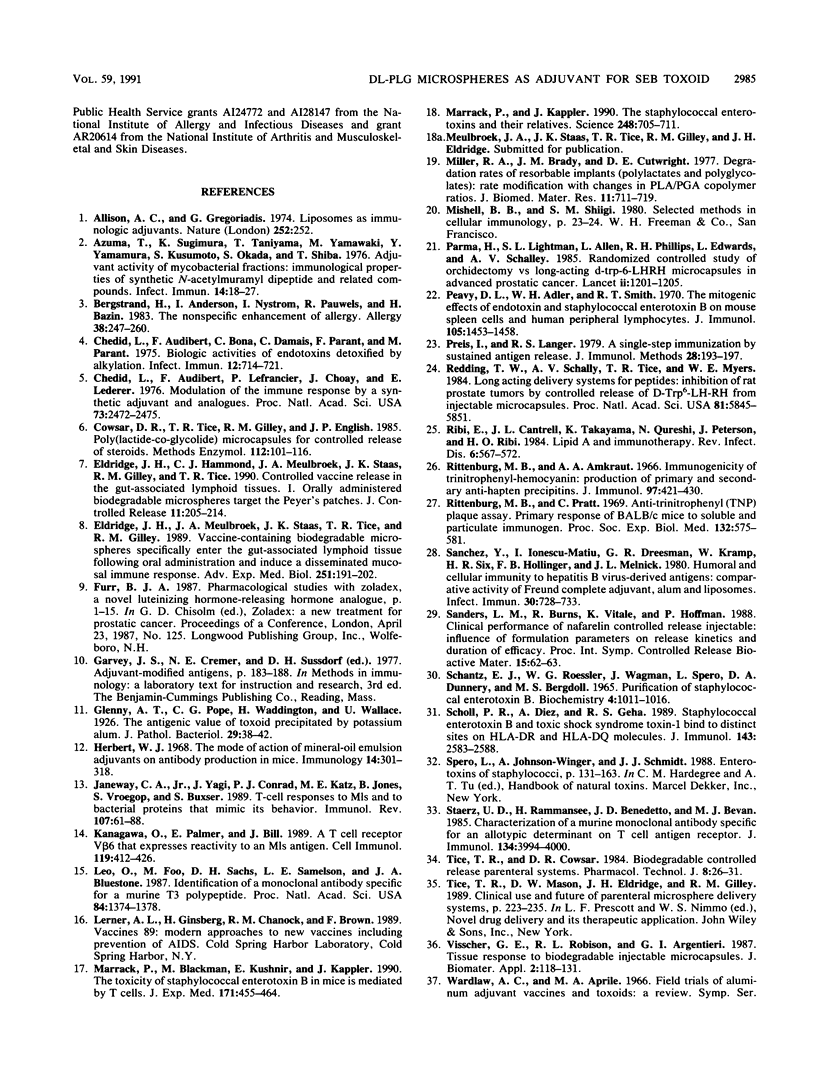
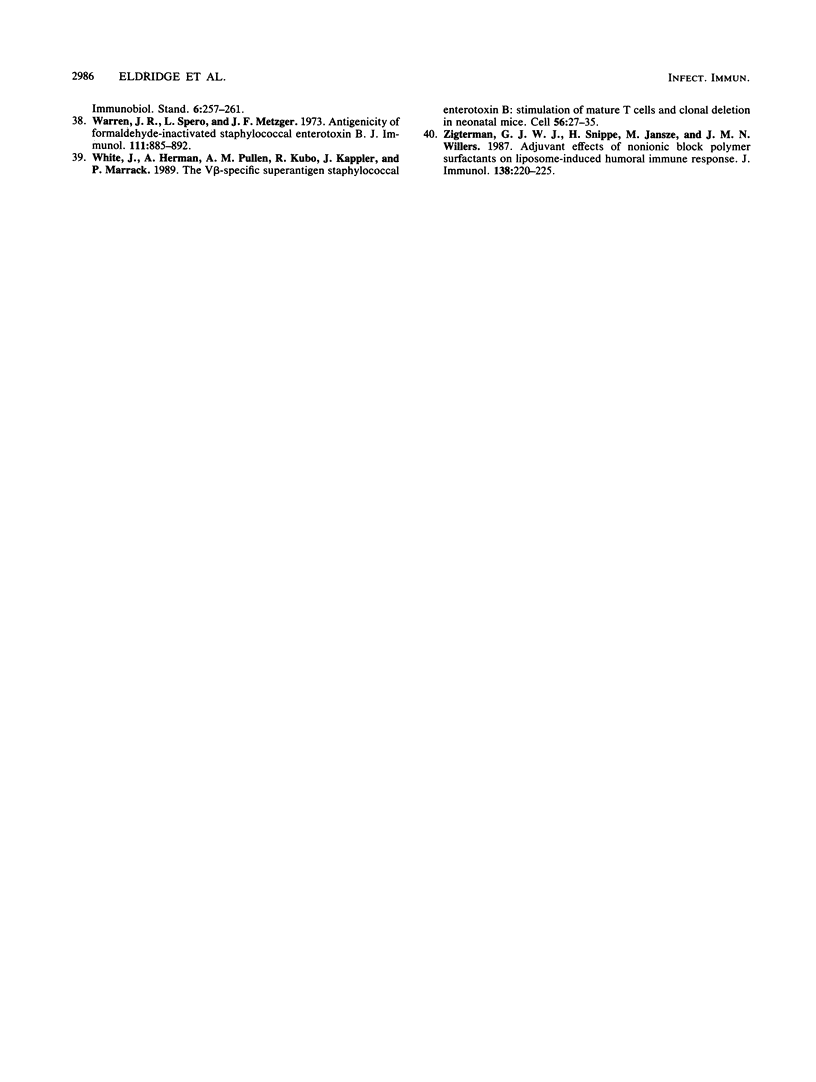
Selected References
These references are in PubMed. This may not be the complete list of references from this article.
- Allison A. G., Gregoriadis G. Liposomes as immunological adjuvants. Nature. 1974 Nov 15;252(5480):252–252. doi: 10.1038/252252a0. [DOI] [PubMed] [Google Scholar]
- Azuma I., Sugimura K., Taniyama T., Yamawaki M., Yamamura Y. Adjuvant activity of mycobacterial fractions: adjuvant activity of synthetic N-acetylmuramyl-dipeptide and the related compounds. Infect Immun. 1976 Jul;14(1):18–27. doi: 10.1128/iai.14.1.18-27.1976. [DOI] [PMC free article] [PubMed] [Google Scholar]
- Bergstrand H., Andersson I., Nyström I., Pauwels R., Bazin H. The non-specific enhancement of allergy. II. Precipitation of anaphylactic in vitro response capacity and serum IgE and IgG2a antibody synthesis in primed but non-responding rats by injection of alum. Allergy. 1983 May;38(4):247–260. doi: 10.1111/j.1398-9995.1983.tb01618.x. [DOI] [PubMed] [Google Scholar]
- Chedid L., Audibert F., Bona C., Damais C., Parant F., Parant M. Biological activities of endotoxins detoxified by alkylation. Infect Immun. 1975 Oct;12(4):714–721. doi: 10.1128/iai.12.4.714-721.1975. [DOI] [PMC free article] [PubMed] [Google Scholar]
- Chedid L., Audibert F., Lefrancier P., Choay J., Lederer E. Modulation of the immune response by a synthetic adjuvant and analogs. Proc Natl Acad Sci U S A. 1976 Jul;73(7):2472–2475. doi: 10.1073/pnas.73.7.2472. [DOI] [PMC free article] [PubMed] [Google Scholar]
- Cowsar D. R., Tice T. R., Gilley R. M., English J. P. Poly(lactide-co-glycolide) microcapsules for controlled release of steroids. Methods Enzymol. 1985;112:101–116. doi: 10.1016/s0076-6879(85)12010-0. [DOI] [PubMed] [Google Scholar]
- Eldridge J. H., Meulbroek J. A., Staas J. K., Tice T. R., Gilley R. M. Vaccine-containing biodegradable microspheres specifically enter the gut-associated lymphoid tissue following oral administration and induce a disseminated mucosal immune response. Adv Exp Med Biol. 1989;251:191–202. doi: 10.1007/978-1-4757-2046-4_18. [DOI] [PubMed] [Google Scholar]
- Herbert W. J. The mode of action of mineral-oil emulsion adjuvants on antibody production in mice. Immunology. 1968 Mar;14(3):301–318. [PMC free article] [PubMed] [Google Scholar]
- Janeway C. A., Jr, Yagi J., Conrad P. J., Katz M. E., Jones B., Vroegop S., Buxser S. T-cell responses to Mls and to bacterial proteins that mimic its behavior. Immunol Rev. 1989 Feb;107:61–88. doi: 10.1111/j.1600-065x.1989.tb00003.x. [DOI] [PubMed] [Google Scholar]
- Kanagawa O., Palmer E., Bill J. The T cell receptor V beta 6 domain imparts reactivity to the Mls-1a antigen. Cell Immunol. 1989 Apr 1;119(2):412–426. doi: 10.1016/0008-8749(89)90255-4. [DOI] [PubMed] [Google Scholar]
- Leo O., Foo M., Sachs D. H., Samelson L. E., Bluestone J. A. Identification of a monoclonal antibody specific for a murine T3 polypeptide. Proc Natl Acad Sci U S A. 1987 Mar;84(5):1374–1378. doi: 10.1073/pnas.84.5.1374. [DOI] [PMC free article] [PubMed] [Google Scholar]
- Marrack P., Blackman M., Kushnir E., Kappler J. The toxicity of staphylococcal enterotoxin B in mice is mediated by T cells. J Exp Med. 1990 Feb 1;171(2):455–464. doi: 10.1084/jem.171.2.455. [DOI] [PMC free article] [PubMed] [Google Scholar]
- Marrack P., Kappler J. The staphylococcal enterotoxins and their relatives. Science. 1990 May 11;248(4956):705–711. doi: 10.1126/science.2185544. [DOI] [PubMed] [Google Scholar]
- Miller R. A., Brady J. M., Cutright D. E. Degradation rates of oral resorbable implants (polylactates and polyglycolates): rate modification with changes in PLA/PGA copolymer ratios. J Biomed Mater Res. 1977 Sep;11(5):711–719. doi: 10.1002/jbm.820110507. [DOI] [PubMed] [Google Scholar]
- Parmar H., Phillips R. H., Lightman S. L., Edwards L., Allen L., Schally A. V. Randomised controlled study of orchidectomy vs long-acting D-Trp-6-LHRH microcapsules in advanced prostatic carcinoma. Lancet. 1985 Nov 30;2(8466):1201–1205. doi: 10.1016/s0140-6736(85)90739-1. [DOI] [PubMed] [Google Scholar]
- Peavy D. L., Adler W. H., Smith R. T. The mitogenic effects of endotoxin and staphylococcal enterotoxin B on mouse spleen cells and human peripheral lymphocytes. J Immunol. 1970 Dec;105(6):1453–1458. [PubMed] [Google Scholar]
- Preis I., Langer R. S. A single-step immunization by sustained antigen release. J Immunol Methods. 1979;28(1-2):193–197. doi: 10.1016/0022-1759(79)90341-7. [DOI] [PubMed] [Google Scholar]
- Redding T. W., Schally A. V., Tice T. R., Meyers W. E. Long-acting delivery systems for peptides: inhibition of rat prostate tumors by controlled release of [D-Trp6]luteinizing hormone-releasing hormone from injectable microcapsules. Proc Natl Acad Sci U S A. 1984 Sep;81(18):5845–5848. doi: 10.1073/pnas.81.18.5845. [DOI] [PMC free article] [PubMed] [Google Scholar]
- Ribi E., Cantrell J. L., Takayama K., Qureshi N., Peterson J., Ribi H. O. Lipid A and immunotherapy. Rev Infect Dis. 1984 Jul-Aug;6(4):567–572. doi: 10.1093/clinids/6.4.567. [DOI] [PubMed] [Google Scholar]
- Rittenberg M. B., Amkraut A. A. Immunogenicity of trinitrophenyl-hemocyanin: production of primary and secondary anti-hapten precipitins. J Immunol. 1966 Sep;97(3):421–430. [PubMed] [Google Scholar]
- Rittenberg M. B., Pratt K. L. Antitrinitrophenyl (TNP) plaque assay. Primary response of Balb/c mice to soluble and particulate immunogen. Proc Soc Exp Biol Med. 1969 Nov;132(2):575–581. doi: 10.3181/00379727-132-34264. [DOI] [PubMed] [Google Scholar]
- Sanchez Y., Ionescu-Matiu I., Dreesman G. R., Kramp W., Six H. R., Hollinger F. B., Melnick J. L. Humoral and cellular immunity to hepatitis B virus-derived antigens: comparative activity of Freund complete adjuvant alum, and liposomes. Infect Immun. 1980 Dec;30(3):728–733. doi: 10.1128/iai.30.3.728-733.1980. [DOI] [PMC free article] [PubMed] [Google Scholar]
- Schantz E. J., Roessler W. G., Wagman J., Spero L., Dunnery D. A., Bergdoll M. S. Purification of staphylococcal enterotoxin B. Biochemistry. 1965 Jun;4(6):1011–1016. doi: 10.1021/bi00882a005. [DOI] [PubMed] [Google Scholar]
- Scholl P. R., Diez A., Geha R. S. Staphylococcal enterotoxin B and toxic shock syndrome toxin-1 bind to distinct sites on HLA-DR and HLA-DQ molecules. J Immunol. 1989 Oct 15;143(8):2583–2588. [PubMed] [Google Scholar]
- Staerz U. D., Rammensee H. G., Benedetto J. D., Bevan M. J. Characterization of a murine monoclonal antibody specific for an allotypic determinant on T cell antigen receptor. J Immunol. 1985 Jun;134(6):3994–4000. [PubMed] [Google Scholar]
- Visscher G. E., Robison M. A., Argentieri G. J. Tissue response to biodegradable injectable microcapsules. J Biomater Appl. 1987 Jul;2(1):118–131. doi: 10.1177/088532828700200103. [DOI] [PubMed] [Google Scholar]
- Warren J. R., Spero L., Metzger J. F. Antigenicity of formaldehyde-inactivated staphylococcal enterotoxin B. J Immunol. 1973 Sep;111(3):885–892. [PubMed] [Google Scholar]
- White J., Herman A., Pullen A. M., Kubo R., Kappler J. W., Marrack P. The V beta-specific superantigen staphylococcal enterotoxin B: stimulation of mature T cells and clonal deletion in neonatal mice. Cell. 1989 Jan 13;56(1):27–35. doi: 10.1016/0092-8674(89)90980-x. [DOI] [PubMed] [Google Scholar]
- Zigterman G. J., Snippe H., Jansze M., Willers J. M. Adjuvant effects of nonionic block polymer surfactants on liposome-induced humoral immune response. J Immunol. 1987 Jan 1;138(1):220–225. [PubMed] [Google Scholar]


